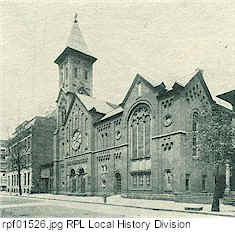
The old Universalist Church
Bragdon in Rochester, 1904-1923
By around 1904, Bragdon was a well-established architect and a happily married man. His personal style was evolving. He was influenced by his friendship with Harvey Ellis, who had introduced him to new ways of looking at color and given him an appreciation for Japanese prints. He was also an early admirer and promoter of the architect Louis Sullivan. Although Bragdon was able to design buildings in many different styles for clients of varying tastes, he was soon to find projects in Rochester which would allow him to make his own stamp upon the city and the world of architecture. These would allow him to merge his diverse interests of Renaissance Italian style, Gothic style, Theosophy, the occult and mathematics. One of his most unique designs, that of the First Universalist Church, is from this time period.
First Universalist Church. One of Claude Bragdon's most impressive achievements in Rochester that still stands is the First Universalist Church. This building, located on Court Street at S. Clinton Avenue in downtown Rochester, was built to replace a church located at S. Clinton near Main Street, built in 1847, but which had been remodeled in 1901. The old church was to be razed for the construction of the Seneca Hotel. In 1907, the church committee recommended that Claude Bragdon be hired to design the new building. He became involved in almost every aspect of its design, from the shape of the structure all the way to the design of the church pews. Bragdon also incorporated many of the windows from the old church into his design, including the "Sargent window" (a beautiful stained-glass depiction of Jesus), several memorial windows, rose windows from the dome, and others.
The church was built in the Lombard Romanesque style, and was also believed to have been partly inspired by the style of the Hagia Sophia in Constantinople/Istanbul. Bragdon also put his own philosophy and religious leanings into his design. Symbols were used which expressed his view of the universality of religion and of his belief in mysticism. Cross patterns, Gothic arches, and circles all held specific meanings for Bragdon, especially when placed in certain numerical groupings.
| Left, an early view of the new church; right, exterior detail, showing brick and tile work, with Xerox Tower in the background | |

View from across S. Clinton Avenue
Below, the front and reverse of a brochure from a Landmark Society of Western New York exhibit (1967) on Bragdon, showing some of his plans used for the church, including the entrance and some of the church furnishings.
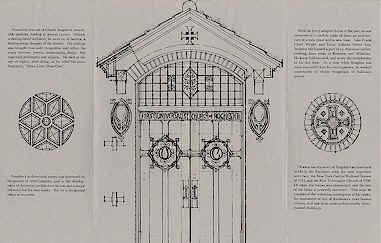
Used by permission of the Landmark Society of
Western New York
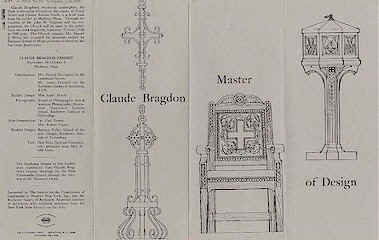
Used by permission of the Landmark Society of
Western New York
|
|
|
Two detail views of brick and tile work on the building |
|
The Bevier Building. In 1908 Bragdon designed the Bevier Building for the Rochester Athenaeum & Mechanics Institute. This building, located at the corner of Spring and S. Washington Streets, was designed to be used as classroom and lecture space for the arts program at the Athenaeum, the predecessor institution of the Rochester Institute of Technology. This structure, like that of the First Universalist Church, made extensive use of brick and ornamental tile work. This work was a personal favorite of Bragdon.
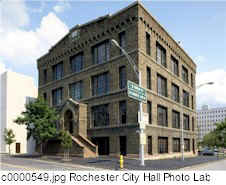
Bevier Building, as seen in 1981
Ontario County Historical Society and Library Building. Bragdon also designed the Post-Colonial style building for the Ontario County Historical Society and Library. It is one of the few buildings in New York State originally designed for use as a museum. For many years the museum and the Canandaigua Library existed side by side in this brick building along Main Street in Canandaigua, New York. It was constructed from 1912-1914, and opened for use in 1914. The library later moved to another location up the street, but the museum still exists in Bragdon's building.
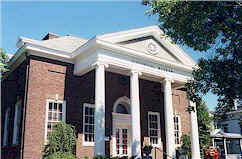
Ontario County Historical Society
Bragdon as lecturer. During this time, Bragdon was interested in Post-Colonial and Classic Revival style and also in cobblestone buildings. He gave lectures on the early structures of Western New York and their architects.
Here is an announcement for one of those lectures, along with a letter from Bragdon to an attorney, Edward R. Foreman, written directly after the lecture. The announcement card features a drawing by Claude Bragdon
|
|
|
Announcement for a Bragdon lecture |
Letter from Bragdon |
Personal details. In 1911, Bragdon's wife Charlotte died after giving birth to the couple's second son. Bragdon threw himself into his work and the absorbing task of raising two motherless boys. In 1912 he was married for the second time, to Eugenie Julier Macaulay. Eugenie was considered by others, including her husband, to have psychic and mystical powers. Her life experiences strongly influenced Bragdon's life and outlook long after her death in 1920.
New York Central Railroad Station, 1914. In 1912, Bragdon received a commission for what is generally acknowledged to be his architectural masterpiece, Rochester's New York Central Railroad Station.
See pictures and more information on the station.
Read Bragdon's own account of his design.
Miscellaneous Commissions. Bragdon worked on a variety of projects during this time, from floats to YMCA buildings. He also began his own publishing venture, the Manas Press, which published works on Theosophy and the poetry of Adelaide Crapsey.
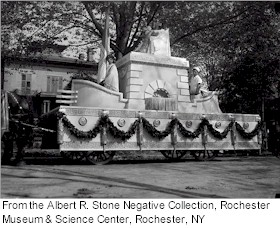
A Chamber of Commerce float, designed by
Bragdon for Rochester's Industrial Exposition of 1910
|
||
|
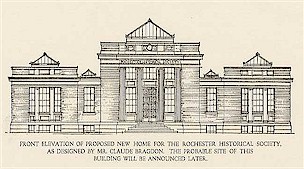
Plan for a proposed new home for the
Rochester Historical Society, never built. Source: RPL Local History Division
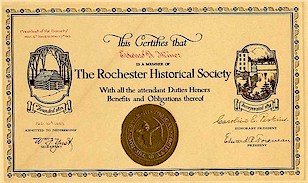
A certificate designed by Bragdon for
the Rochester Historical Society. Source: RPL Local History Division
Chamber of Commerce Building. In 1917, Bragdon began what was to become his last major commission in Rochester, the new Chamber of Commerce Building. The prime benefactor of the construction was George Eastman. Bragdon and Eastman were to have a falling out over the designs for the building. Bragdon provided his own version of the disagreement in his autobiography, More Lives Than One. The rift between the two was not healed until many years later.
The Chamber of Commerce Building, now and then |
|
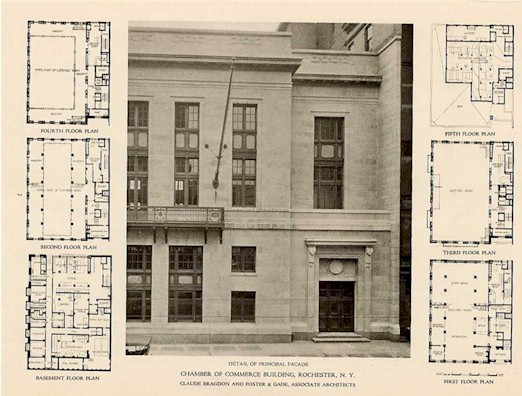
A view of the building's fašade and floor
plans, from The Home of the Rochester Chamber of Commerce, 1918.
Click on each floor's plan for a closer look.
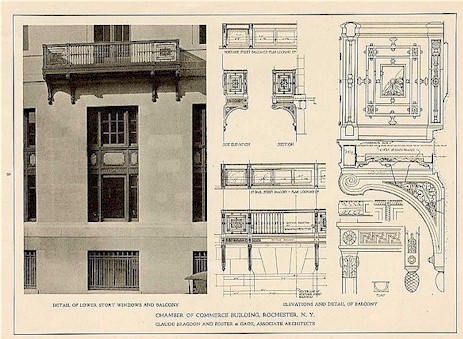
Elevations and details, The Home of the Rochester Chamber of Commerce, page 8
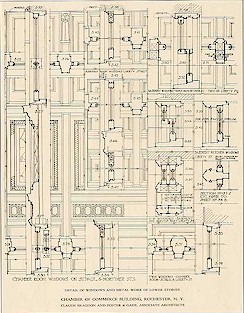
Detail of windows and metal work of lower stories,
The Home of the Rochester Chamber of Commerce, page 9
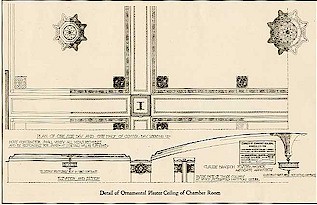
Detail of Ornamental Plaster Ceiling
of Chamber Room,
The Home of the Rochester Chamber of Commerce, page 6
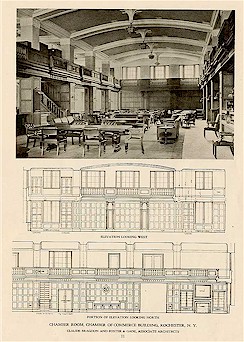
The Chamber Room,
The Home of the Rochester Chamber of
Commerce
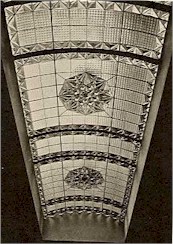
Crystal ceiling light over stairwell,
The Home of the Rochester Chamber of Commerce, page 12
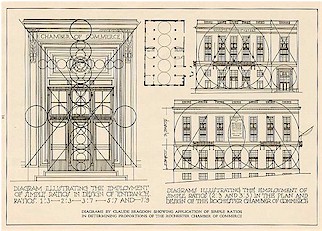
Diagrams by Claude Bragdon showing
application of simple ratios in determining proportions of the Rochester Chamber of
Commerce,
The Home of the Rochester Chamber of Commerce, page 14

Illustrations of preliminary model and
completed building from similar viewpoints,
The Home of the Rochester Chamber of Commerce, page 15
See more pictures of the Chamber of Commerce from the Albert R. Stone collection
Introduction | Previous Page | Next Page
Send comments to Webmaster
Copyright 2021
Monroe County (NY) Library System
115 South Ave., Rochester, NY 14604